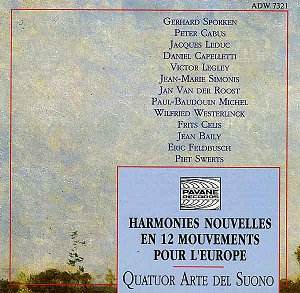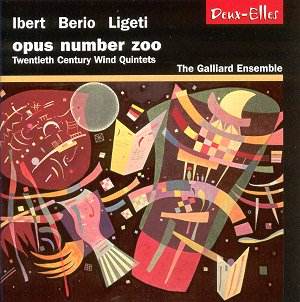 Composer: HARMONIES
Composer: HARMONIES
Works: NOUVELLES POUR L’EUROPE
Performers: Arte del Suono Quartet (Lola Bobesco, Suzanne Janssens, violins; Jean-Elie Homatas, viola; Jan Matthe, cello), Rafaël Macaluso (trumpet), Armand Rahier (oboe)
Recording: Chapelle de Berchem-Ste-Agathe, Brussels, June 1994
Label: PAVANE ADW 7321
The project encapsulated in “Nouvelles pour l’Europe” emerges from a unique collaborative spirit among Belgian composers, inspired by Lola Bobesco’s vision. This endeavor, which invites thirteen composers from various generations to respond musically to the twelve nations of the European Community, offers a fascinating snapshot of contemporary Belgian music in 1993. Each piece, while distinct in voice, contributes to a broader narrative of European unity and cultural diversity, making this collection a noteworthy exploration of national identities through the lens of classical music.
The Arte del Suono Quartet, alongside distinguished soloists Rafaël Macaluso and Armand Rahier, navigates this diverse repertoire with commendable finesse. Gehrard Sporken’s opening “Quasi una Ouvertura – Hymne” serves as a fanfare that sets the stage for the subsequent pieces. Its blend of a ceremonial string introduction with a trumpet fanfare captures a sense of anticipation, culminating in an echo of Charpentier’s Te Deum, which adds a layer of historical resonance. The performers handle the dynamic contrasts with precision, allowing the work’s celebratory nature to shine through.
Peter Cabus’s “Twee geusenlieder,” which alludes to Dutch folk tales, is rendered with a charming simplicity that reflects the composer’s homage to his country’s history. The juxtaposition of strings and trumpet creates a vivid soundscape, successfully evoking the spirit of resistance embodied in the piece. Similarly, Jacques Leduc’s “Intrada et Danserie Op.75” pays tribute to Orlando di Lasso, with intricate polyphonic textures that the ensemble executes with clarity. The ensemble’s ability to maintain a delicate balance between individual expression and cohesive ensemble playing is particularly noteworthy.
The recording quality is commendable, capturing the rich tonal colors of the instruments while presenting a well-defined spatial representation of the performance space. The reverberation of the Chapelle de Berchem-Ste-Agathe enhances the strings’ warmth, allowing the subtle nuances of each composer’s voice to emerge distinctly. This is especially evident in Daniel Capelletti’s “Me compare,” where the string quartet’s lyrical lines intertwine beautifully with the oboe, creating an intimate dialogue that resonates deeply.
Wilfried Westerlinck’s “Scherzo Tedesco” intriguingly nods to Beethoven, yet it stands apart in its playful irony and rhythmic vitality. The performers navigate its brisk tempo while maintaining a sense of humor, showcasing their versatility. In contrast, Frits Celis’s “Il canto della Piccina Sirena Op.48” evokes a haunting atmosphere, and the ensemble’s control over dynamics allows the work’s dreamlike qualities to flourish. Each composer’s stylistic differences are articulated effectively, revealing the rich tapestry of Belgian musical language.
The closing piece, “Zortzico,” serves as a jubilant conclusion, encapsulating the celebratory essence of the entire collection. Its lively rhythms and vibrant melodies leave the listener with a sense of joy, effectively summing up the collaborative spirit that the project embodies. This disc stands as both an introduction to contemporary Belgian composers and a testament to their ability to convey national characteristics through music.
This collection is not merely a compilation of short works; rather, it is a significant contribution to the understanding of Belgian music within a European context. The performances are characterized by a blend of sensitivity and technical prowess, effectively capturing the essence of each composition. Such an endeavor not only enriches the listener’s experience but also invites further exploration of the individual composers’ broader oeuvres. The project succeeds in presenting a cohesive yet diverse exploration of European identity through music, making it a valuable addition to the contemporary classical repertoire.



